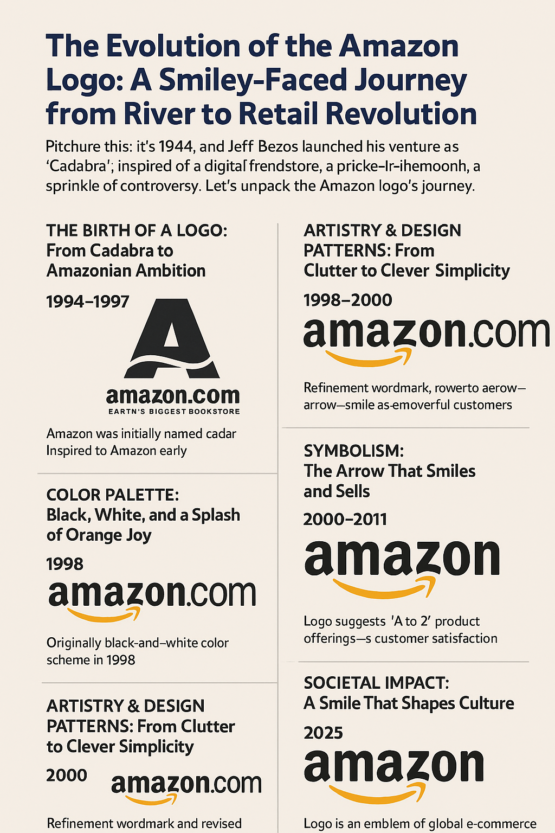A Smiley-Faced Journey from River to Retail Revolution.
Picture this: it’s 1994, and Jeff Bezos is tinkering away in his Seattle garage, dreaming of a digital bookstore. Fast forward to 2025, and Amazon is a retail giant—and a perfect case study for anyone using a logo generator AI with prompt to create meaningful, memorable branding. But what’s one constant through this wild ride? That iconic logo—the lowercase “amazon” with its cheeky orange arrow-smile, whispering promises of “A to Z” convenience. It’s more than a design; it’s a story of ambition, evolution, and a sprinkle of controversy. Let’s unpack the Amazon logo’s journey, exploring its birth, colors, artistry, symbolism, societal impact, and everything in between. Buckle up—this is no ordinary logo tale.
The Birth of a Logo: From Cadabra to Amazonian Ambition
Amazon didn’t start as “Amazon.” In 1994, Bezos launched his venture as “Cadabra, Inc.,” a nod to “abracadabra”—magic, creation, the works. But as Bezos later recounted, his lawyer misheard it as “cadaver” over the phone. “Yeah, let’s not sell books under a name that sounds like dead bodies,” he quipped (probably). By 1995, Bezos pivoted to “Amazon,” inspired by the world’s largest river—a metaphor for the scale he envisioned. Alphabetical advantage didn’t hurt either; “A” put him at the top of early internet directories.
The first logo, designed by Turner Duckworth in 1995, was a literal love letter to that name. A bold, black “A” stood tall, sliced by a white curve mimicking the Amazon River’s flow, with “amazon.com” and “Earth’s Biggest Bookstore” in sans-serif below. It screamed simplicity but oozed ambition. Critics weren’t kind, though. “It looks like someone went wild with Microsoft Word clip art,” graphic design professor Ryan Edward Russell once jabbed. Yet, for a fledgling online bookstore, it was a bold opening chapter.
Color Palette: Black, White, and a Splash of Orange Joy
Color tells a story, and Amazon’s logo evolution is a masterclass in hue psychology. The 1995 original stuck to a monochrome black-and-white scheme—practical for the digital dawn when printers and screens weren’t exactly high-tech. Black exuded authority; white kept it clean. But it was functional, not flashy.
By 1997, the palette stayed monochrome, adding horizontal white lines to the “A” for a zebra-like flair. Still, it felt like a logo stuck in grayscale purgatory. Then came 1998’s pivot: a bright yellow-orange “swish” beneath “amazon.com.” Enter 2000, and that swish morphed into the iconic arrow-smile, cementing orange as Amazon’s signature. Why orange? “It’s joy, warmth, and a call to action,” says design expert Claudine Jaenichen. It’s the color of a sunrise—or a “Buy Now” button. Today, that orange grin is as recognizable as the golden arches, proving less is more when you pick the right shade.

Artistry and Design Patterns: From Clutter to Clever Simplicity
The artistry of Amazon’s logo is a tale of shedding excess for elegance. The 1995 design was raw—think trapezoidal “A” with a river squiggle. It was symbolic but cluttered, a product of limited digital tools. “It didn’t adapt well to print,” Russell noted, and it showed.
In 1997, Turner Duckworth refined it, adding horizontal lines to evoke trees or zebra stripes. Creative? Sure. Memorable? Not quite. It lasted barely a year—a design speed bump. Then 1998 hit, and Amazon tested three logos: a serif “amazon.com” with “Earth’s Biggest Bookstore,” a quirky version with a giant “O” ring, and finally, a lowercase wordmark with a yellow swish. “It’s like Amazon was having a midlife crisis and bought a Corvette,” Jaenichen mused about the “O” experiment.
The real artistry arrived in 2000. The swish became an arrow, stretching from “a” to “z,” doubling as a smile. Officina Sans Bold font grounded it—sleek, modern, readable. “Simplicity is the ultimate sophistication,” Leonardo da Vinci once said, and Amazon nailed it. This wasn’t just a logo; it was a design pattern for the ages: minimalism with maximum meaning.
Symbolism: The Arrow That Smiles and Sells
If logos are visual poetry, Amazon’s is a haiku. That orange arrow? It’s no accident. Stretching from “a” to “z,” it whispers, “We’ve got everything.” Doubling as a smile, it purrs, “And we’ll make you happy.” Turner Duckworth’s stroke of genius turned a line into a philosophy. “It’s a smirk of confidence,” Jaenichen says, “not condescending, but knowing.”
The river motif of the early logos nodded to Amazon’s namesake, symbolizing knowledge and flow. By 2000, the shift to the arrow reflected a broader mission: not just books, but everything, delivered with a grin. It’s subliminal brilliance—research shows humans trust smiling faces, and Amazon banked on that. “We’re customer-obsessed, not competitor-obsessed,” Bezos once declared, and the logo embodies that ethos.
Controversies: When a Logo Brushes with History
Even icons stumble. In January 2021, Amazon tweaked its app logo—a brown box with a blue, toothed tape strip. Cue the internet: “It looks like Hitler’s mustache!” Social media erupted, and within weeks, Amazon smoothed the edges into a folded tape design. “We wanted to spark joy, not dredge up history,” a spokesperson said. It was a rare misstep, swiftly corrected, proving even giants aren’t immune to design drama.
The backlash highlighted a truth: logos aren’t just art; they’re cultural lightning rods. Amazon learned the hard way—test your designs, folks, lest they evoke the wrong ghosts.
Defining Eras: A Logo Through Amazon’s Ages
Amazon’s logo marks its eras like rings on a tree. The 1995-1997 river phase was the Bookstore Era—humble, focused, a startup’s dream. 1998’s experiments were the Identity Crisis Era, as Amazon outgrew books for toys, electronics, and more. The 2000 logo ushered in the E-Commerce Titan Era, aligning with the marketplace launch and Bezos’s “A to Z” vision.
By 2012, dropping “.com” signaled the Global Empire Era—think Prime, AWS, and Alexa. Each tweak mirrored Amazon’s growth from garage hustle to trillion-dollar titan. “The logo evolved with the company’s soul,” says design historian Stuart Crawford. It’s a timestamp of ambition realized.
Design Lessons: What Amazon Teaches Creatives
Amazon’s logo offers a playbook for designers:
- Keep It Simple: Complexity confuses; clarity converts.
- Embrace Symbolism: A smile sells trust; an arrow sells scope.
- Color Counts: Orange energizes; black grounds.
- Adapt or Die: From rivers to arrows, evolve with your brand.
- Test, Test, Test: Avoid a Hitler-mustache moment.
“Persistence is key,” writes Looka’s design team. Amazon’s iterations prove you don’t nail it on day one—but you keep refining until you do.
Societal Impact: A Smile That Shapes Culture
Amazon’s logo isn’t just branding; it’s a societal fixture. That smile graces millions of packages daily, a Pavlovian trigger for excitement. “It’s become shorthand for convenience,” says branding expert Mia Vargas. Amazon Prime Day—logo front and center—rivals Black Friday, reshaping retail calendars.
The logo’s ubiquity fuels debates, too. Critics decry Amazon’s labor practices; fans laud its innovation. Either way, that arrow-smile is inescapable, a symbol of how tech giants infiltrate daily life. “It’s not just a logo; it’s a promise delivered to your doorstep,” Vargas adds.
Design Anatomy: Dissecting the Smiley Arrow
Let’s break it down:
- Typography: Officina Sans Bold—bold, lowercase, approachable yet authoritative.
- Arrow-Smile: Orange, curved, no sharp edges—inviting and dynamic.
- Spacing: Tight but balanced, ensuring legibility at any size.
- Color Contrast: Black text, orange accent—pops on any background.
It’s a deceptively simple anatomy, engineered for recognition. “The arrow’s lack of an arrowhead softens it into a smile,” notes designer Ali Haider. Every pixel serves a purpose.
Messaging: From Bookstore to “Everything Store”
The logo’s message evolved with Amazon. “Earth’s Biggest Bookstore” in 1995 was literal—books were the game. By 2000, the arrow-smile said, “We’re your one-stop shop.” Dropping “.com” in 2012 screamed confidence: “You know who we are.”
It’s a messaging arc from niche to omnipresent. “The logo tells customers, ‘We’ve got you covered,’” says Russell. Subtle yet loud, it’s branding alchemy. Simplicity is key—just as any effective logo generator AI with prompt strives to achieve.
Hashtag History: #AmazonSmile and Beyond
Social media amplified the logo’s reach. #AmazonSmile, tied to the charity program, turned the grin into a feel-good hashtag. #PrimeDay plastered it across X, Instagram, and TikTok, cementing its cultural cachet. “The logo’s a hashtag star,” says influencer Ali Haider. It’s clickable proof of Amazon’s digital dominance.
Growth: A Logo Scaling with a Giant
Amazon’s growth—from $20,000 weekly sales in 1995 to $135 million in 2016—mirrors the logo’s refinement. The 2000 design scaled with the company, adorning subsidiaries like AWS and Prime without losing its core. “It’s a logo that grew up with Amazon,” Crawford says. From garage to global, it’s a visual constant amid exponential expansion.
Impact of Technology: Digital Design’s Role
Tech shaped the logo’s journey. The 1995 design leaned on basic tools—think Microsoft Paint vibes. By 2000, digital precision allowed the arrow’s curve to shine. “Technology let us simplify without losing meaning,” a Turner Duckworth designer once hinted. Today, the logo adapts to apps, wearables, and drones, proving tech isn’t just Amazon’s product—it’s the logo’s backbone.
Wittiness in Wrap-Up: The Logo That Keeps on Grinning
So, here we are in April 2025, staring at a logo that’s outlasted trends, controversies, and a few too many cardboard boxes. From a river-riffing “A” to a smirking arrow, Amazon’s logo is a testament to design’s power. It’s witty—hiding a smile in a sales pitch. It’s human—evolving through missteps. And it’s SEO gold—try searching “Amazon logo” without drowning in hits. If you’re experimenting with a logo generator AI with prompt, Amazon’s logo evolution offers a perfect inspiration for balancing symbolism and simplicity.
Bezos once said, “Your brand is what people say about you when you’re not in the room.” With this logo, they’re saying, “Fast, friendly, and everywhere.” Whether you love or loathe Amazon, that orange grin isn’t going anywhere. So, next time a package lands on your porch, tip your hat to the logo that smiled its way into history. Whether you’re using a design team or a logo generator AI with prompt, storytelling remains the heart of good branding.
✨ Want a logo that bridges the digital divide and emotion?
Try our free logo generator AI tool to start crafting your own iconic mark.
If you are looking to avoid some logo design mistakes, then keep reading our other blog articles.
